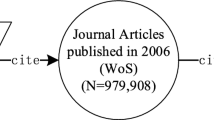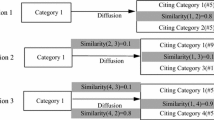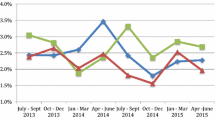Abstract
In this paper, we compare the distribution of Elsevier Scopus subject areas of authors’ documents, their bibliographical references and their citing documents. We compute the complement of the Herfindahl–Hirschman index as a measure of multidisciplinarity. We analyse a sample of 120 researchers belonging to two groups, one from the Italian Institute of Technology (IIT, whose work is expected to be highly multidisciplinary) and one from the National Institute for Nuclear Physics (INFN, whose work is expected to be much less multidisciplinary). We show that the two groups are distinguishable through the measured index values. By using the subject areas of authors’ bibliographical references we obtain a better identification of the two groups than relying on the subject areas of the author’s documents. We then extend the analysis to 3317 researchers belonging to seven Italian Scientific-Disciplinary sectors (SSD) providing insights about the degree of multidisciplinarity within each SSD. The results seem interesting for assessing the multidisciplinarity of younger researchers with scarce scientific output and few citations.



Similar content being viewed by others
Notes
See further information at https://www.iit.it/about-us/institute.
See further information at http://home.infn.it/en/.
References
Abramo, G., D’Angelo, C. A., & Di Costa, F. (2012). Identifying interdisciplinarity through the disciplinary classification of coauthors of scientific publications. Journal of the American Society for Information Science and Technology, 63(11), 2206–2222.
Abramo, G., D’Angelo, C. A., & Di Costa, F. (2018a). The effect of multidisciplinary collaborations on research diversification. Scientometrics, 116(1), 423–433.
Abramo, G., D’Angelo, C. A., & Zhang, L. (2018b). A comparison of two approaches for measuring interdisciplinary research output: The disciplinary diversity of authors vs the disciplinary diversity of the reference list. Journal of Informetrics, 12(4), 1182–1193.
Boyack, K. W., & Klavans, R. (2010). Co-citation analysis, bibliographic coupling, and direct citation: Which citation approach represents the research front most accurately? Journal of the American Society for Information Science and Technology, 61(12), 2389–2404.
Choi, B. C., & Pak, A. W. (2006). Multidisciplinarity, interdisciplinarity and transdisciplinarity in health research, services, education and policy: 1. Definitions, objectives, and evidence of effectiveness. Clinical and Investigative Medicine, 29(6), 351–364.
Elsevier. (2019). Elsevier Developers. Retrieved November 11, 2019, from https://dev.elsevier.com/.
Hartigan, J. A., & Wong, M. A. (1979). Algorithm AS 136: A K-means clustering algorithm. Journal of the Royal Statistical Society: Series C (Applied Statistics), 28(1), 100–108.
Klavans, R., & Boyack, K. W. (2017). Research portfolio analysis and topic prominence. Journal of Informetrics, 11(4), 1158–1174.
Leydesdorff, L. (2007). Betweenness centrality as an indicator of the interdisciplinarity of scientific journals. Journal of the American Society for Information Science and Technology, 58(9), 1303–1319.
Leydesdorff, L., & Rafols, I. (2011). Indicators of the interdisciplinarity of journals: Diversity, centrality, and citations. Journal of Informetrics, 5(1), 87–100.
Leydesdorff, L., Rafols, I., & Chen, C. (2013). Interactive overlays of journals and the measurement of interdisciplinarity on the basis of aggregated journal–journal citations. Journal of the American society for Information science and Technology, 64(12), 2573–2586.
MacQueen, J. et al. (1967). Some methods for classification and analysis of multivariate observations. In Proceedings of the 5th Berkeley symposium on mathematical statistics and probability (Vol. 1, pp. 281–297). Oakland, CA, USA.
Moreno, Md C C, Auzinger, T., & Werthner, H. (2016). On the uncertainty of interdisciplinarity measurements due to incomplete bibliographic data. Scientometrics, 107(1), 213–232.
Moschini, U., Fenialdi, E., Daraio, C., Ruocco, G., & Molinari, E. (2019). A comparison of three individual multidisciplinarity indices based on the diversity of the Scopus subject areas, of the bibliography and of the citing papers of an author’s documents. In: Proceedings of international conference on scientometrics and informetrics (ISSI 2019) (Vol. 1, pp, 1226–1231).
Porter, A., Cohen, A., David Roessner, J., & Perreault, M. (2007). Measuring researcher interdisciplinarity. Scientometrics, 72(1), 117–147.
Porter, A., & Rafols, I. (2009). Is science becoming more interdisciplinary? Measuring and mapping six research fields over time. Scientometrics, 81(3), 719–745.
Rafols, I., & Meyer, M. (2007). Diversity measures and network centralities as indicators of interdisciplinarity: Case studies in bionanoscience. Proceedings of International Conference on Scientometrics & Informetrics (ISSI), 2, 631–637.
Rao, C. R. (1982). Diversity: Its measurement, decomposition apportionment and analysis. The Indian Journal of Statistics, Series A (1961–2002), 1(44), 1–22.
Rhoades, S. A. (1993). The Herfindahl–Hirschman index. Federal Reserve Bulletin, 79, 188–189.
Rousseau, R. (2018). The repeat rate: From Hirschman to Stirling. Scientometrics, 116(1), 645–653.
Rousseau, R., Zhang, L., & Hu, X. (2019). Knowledge integration: Its meaning and measurement. In Springer handbook of science and technology indicators (pp. 69–94). Springer.
Shu, F., Julien, C.-A., Zhang, L., Qiu, J., Zhang, J., & Larivière, V. (2019). Comparing journal and paper level classifications of science. Journal of Informetrics, 13(1), 202–225.
Simpson, E. H. (1949). Measurement of diversity. Nature, 163(4148), 688.
Small, H., Boyack, K. W., & Klavans, R. (2014). Identifying emerging topics in science and technology. Research Policy, 43(8), 1450–1467.
Stirling, A. (2007). A general framework for analysing diversity in science, technology and society. Journal of the Royal Society Interface, 4(15), 707–719.
Stokols, D., Fuqua, J., Gress, J., Harvey, R., Phillips, K., Baezconde-Garbanati, L., et al. (2003). Evaluating transdisciplinary science. Nicotine & Tobacco Research, 5(Suppl-1), S21–S39.
Wagner, C. S., Roessner, J. D., Bobb, K., Klein, J. T., Boyack, K. W., Keyton, J., et al. (2011). Approaches to understanding and measuring interdisciplinary scientific research (IDR): A review of the literature. Journal of Informetrics, 5(1), 14–26.
Waltman, L., & Van Eck, N. J. (2012). A new methodology for constructing a publication-level classification system of science. Journal of the American Society for Information Science and Technology, 63(12), 2378–2392.
Wang, J., Thijs, B., & Glänzel, W. (2015). Interdisciplinarity and impact: Distinct effects of variety, balance, and disparity. PLoS ONE, 10(5), e0127298.
Author information
Authors and Affiliations
Corresponding author
Rights and permissions
About this article
Cite this article
Moschini, U., Fenialdi, E., Daraio, C. et al. A comparison of three multidisciplinarity indices based on the diversity of Scopus subject areas of authors’ documents, their bibliography and their citing papers. Scientometrics 125, 1145–1158 (2020). https://doi.org/10.1007/s11192-020-03481-x
Received:
Published:
Issue Date:
DOI: https://doi.org/10.1007/s11192-020-03481-x




